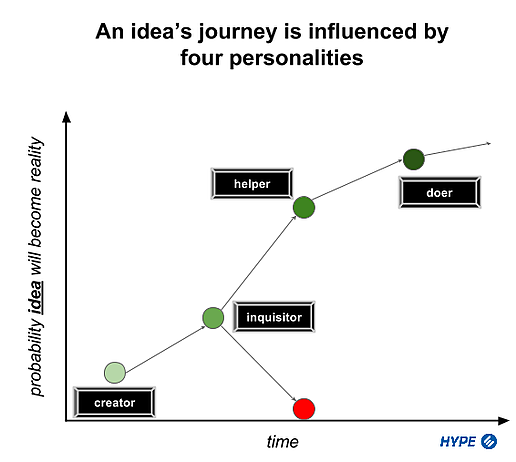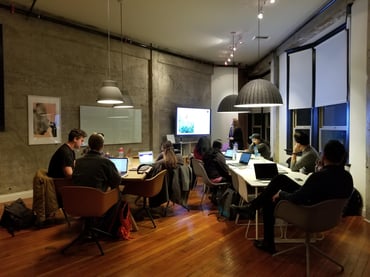Innovation, done right, is an interactive flow of diverse contributions. For sure, it is a process of building on the knowledge, perspectives, and heuristics of multiple people. It's in this diversity where novel solutions emerge. But there's another aspect to it. Think of innovation as a multi-act play. One in which distinct personalities enter the scene at critical times. These personalities, each with unique contributions at the right time, determine innovation's success or failure.
Who Are These Personalities?
Experience shows that there are four main personalities that every organization needs to innovate: the Creator, the Inquisitor, the Helper, and the Doer. Let's discuss why each personality is important for innovation in more detail.
The Creator
Creators are the initial spark. They make a proposal to address some opportunity or need.
Creators come in two archetypes. The first is the "all ideas, all the time" sort of person. You may know someone like this. They have a bottomless interest in investigating new possibilities. They get excited about new technology or business model innovations. While good at providing a seemingly endless flow of concepts, these folks display little appetite for the details to see them through.
The second archetype is the person who has an idea for a specific question. This person is interested in solving a focused need rather than generally seeking what's new. This is the more common archetype you'll find in large-scale communities.
.jpg?width=640&height=427&name=campaign-creators-e6n7uoEnYbA-unsplash%20(1).jpg)
The Inquisitor
This personality is the most interesting one, as the nature of what this person does can elicit negative reactions: "innovation killer", "stuck in the status quo", "downer". The truth is that the Inquisitor plays a vital role in improving innovation.
Inquisitor derives from the Latin "quaerere", which means to ask, seek, or look for. That is what Inquisitors do. They scrub an idea, they have a sense of the chain of steps required to make the idea successful and seek what hindrances there are. It's actually quite a service they provide.
Their questioning makes it clear what's needed to advance an idea. Or, alternatively, they identify fatal flaws that make everyone realize the idea isn't feasible. This is a valuable part of the innovation flow: removing detritus so resources are better applied elsewhere.
One note: don't confuse Inquisitors with the dreaded corporate antibodies. Corporate antibodies seek to kill an idea regardless of its potential. They have an agenda and anything that threatens it must be eliminated. The mark of an Inquisitor looks at the details of an idea and asks about those. Corporate antibodies will talk about generic, unspecific attacks: "That'll never work", "we can't do something like that". Know the difference.
The Helper
The Helper makes the connections that move an idea forward. Ideas with potential inevitably run up against obstacles. These include missing expertise, changes required to existing processes, lack of a critical resource, etc.
The Helper is a person who makes a connection. They see the issue and recognize what is needed to overcome it. What do they connect? People. Knowledge. Another idea. A process. An external partner.
All of these elements are potential breakthroughs to carry an idea forward. The sheer variety of what constitutes 'help' means anybody can be a helper. Each of us has different assets to offer when required. Crowdsourcing is well-suited for integrating the helper into the process because the needed help can come from anywhere.
The Doer
The Doer is the critical transition from concept to innovation. Doers may sound similar to helpers, but their contribution differs. They take an idea that has gone through an iterative series of improvements and formulate the essentials for making it happen.
Make it happen: The path from digital concept to idea realization can take several forms. It may be a full-on project, ready to make an impact quickly. Or it may go through a series of prototypes to get it right. Or a series of experiments may be run to validate aspects of it.
The Doer sees what's needed and understands how to move forward. While helpers supply critical connections as crucial points in an idea's life, the doer coordinates multiple elements needed for the idea to be realized. Doers have an execution mindset and a desire to fill out the pieces to bring an idea to life. There's a pride of craftsmanship for the Doer.

Four Personalities in an Idea's Journey
The contributions of each personality build the idea's journey, as illustrated below:

Each contribution increases the probability of the idea becoming a reality:
- The Creator's initial idea is the spark, but by itself, it has a low probability of advancing;
- The Inquisitor plays a key role in identifying areas of weakness, hurdles, and the like. This actually increases the probability of the idea becoming reality. Why? Finding problems early allows them to be addressed, rather than letting uncertainty hang over the concept or being blindsided by a problem later;
- The Inquisitor also highlights fatal flaws in an idea when present. The journey for this idea ends at this point;
- The Helper makes a connection that resolves an issue the Inquisitor identified. The Helper elevates the idea's probability of success;
- The Doer then goes to work to make it real.
Final Thoughts
Innovation is like a multi-act play, with different personalities playing crucial roles. The Creator initiates the spark of an idea while the Inquisitor critically examines its feasibility. The Helper connects to overcome obstacles, and the Doer transforms the concept into reality. Each personality's contribution increases the idea's probability of success, turning innovation into an interactive flow of diverse contributions. Understanding the significance of each personality is vital for organizations aiming to foster successful innovation.










